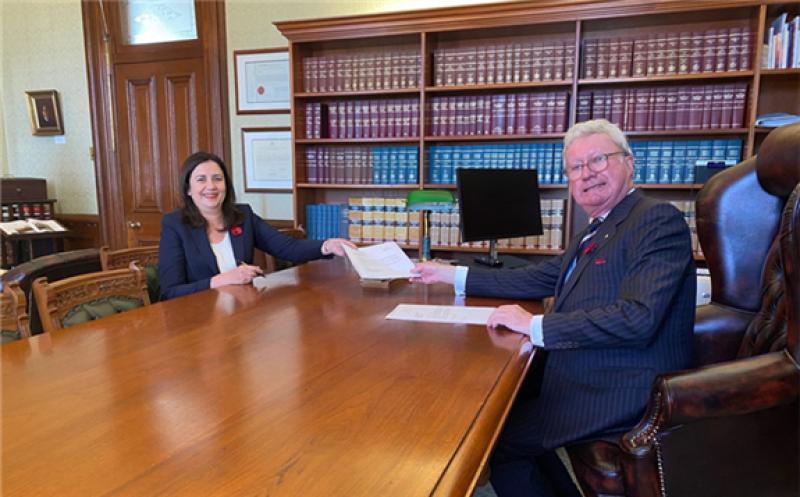Queensland (QLD) may have lost Game II of the 2020 State of Origin series against New South Wales (NSW) but that hasn’t stopped the Sunshine State from trying to one-up its southern rival in the clean energy stakes. Earlier this week, NSW launched its ‘NSW Electricity Infrastructure Roadmap’, a pathway through the retirement of coal-fired power generation through the construction of 12 GW of new large-scale solar and wind. Yesterday however, QLD did something altogether new by establishing a Minister for Hydrogen.

In a statement from newly re-elected Premier and Minister for Trade Annastacia Palaszczuk, the Premier said that the establishment of a ministry for hydrogen recognises “the importance of this valuable new energy source”. The hydrogen portfolio harmoniously joins energy, renewables, public works, and procurement under the ministership of Mick de Brenni. de Brenni previously held the portfolios of housing, public works, digital tech, and sport, but is now moving across to take up the vacancy left through the retirement of Anthony Lynham.
The Australian Hydrogen Council (AHC) welcomed the new ministership, with AHC CEO Fiona Simon congratulating the QLD Premier on this Australian first. “This is the right time to recognise hydrogen with a portfolio in its own right,” said Simon, “By creating a hydrogen portfolio, the Queensland Government recognises hydrogen as an important new industry in the economic recovery, and a great opportunity for Queensland.”
“Even before today’s announcement,” continued Simon, “Queensland has one of the more mature approaches to the hydrogen industry including a Queensland Hydrogen Industry Strategy, development fund, prospectus, investor toolkit and guidance for local governments on hydrogen developments…The Government also allocated $145m for renewable energy zones with ambitions to develop hydrogen hubs.”
Australia fast out of the blocks in the race for Hydrogen
That fact that hydrogen is a big part of Australia’s future is one of the few things all of Australia seems to agree on. Of course, there are polarising opinions about how green Australia’s hydrogen can and should be, but the hydrogen fact is undisputed.
South Australia and Western Australia have been doing most of the early work, but it is important to remember that the pursuit of hydrogen development is a group project. Victoria took the initiative earlier this week through a $2.3 million industry-led hydrogen research project at Deakin University’s Warrnambool campus. And the establishment of a hydrogen ministry in QLD is evidence that no state or territory wants to be left behind.
Federally, the National Hydrogen Strategy looks to achieve the goal of H2 under AU$2, a feat that Australia hopes will ensure its place as a global exporter of hydrogen, particularly in the East Asian market, as well as a widespread domestic integrator of the much-vaunted clean fuel.
Indeed, Frost & Sullivan’s (F&S) recent analysis “Growth Opportunities in the Hydrogen Market for the Global Power Sector”, states that with Australia’s “abundant renewable energy resources and natural gas reserves, the country could efficiently utilise these attributes to become and remain a substantial player in the hydrogen value chain.”
According to F&S, global hydrogen production is set to more double between now and 2030, “reaching 168 million tonnes by 2030 from 71 million tonnes in 2020, with revenue expected to reach $420 billion in 2030 from $177.3 billion in 2020.”
In further good news for Australia’s various initiatives, F&S analyst Swagath Navin Manohar made particular note of the importance of decisive government actions in making the hydrogen economy a reality.
Moreover, Manohar sets out four key areas where decisive government action could prove most efficacious. “Support R&D activities related to technologies involved in the production, storage, transport, and utilisation of hydrogen” said Manohar, “and provide incentives to companies for developing the hydrogen and carbon capture utilisation and storage (CCUS) infrastructure.”
Of course, carbon capture and storage is undoubtedly the most contentious public issue in Australia when it comes to hydrogen, with many decidedly upset at the prospect of anything but a 100% green hydrogen future. However, Manohar seems to agree with Australia’s outgoing Chief Scientist, Alan Finkel, in reckoning that breaking the socio-economic barriers inhibiting the growth of hydrogen technology and permitting scale is essential in these early steps.
“While the cost of establishing a hydrogen economy will be high,” continued Manohar, “the promises associated with hydrogen – as an important tool in catalysing the transition towards sustainable energy economy- are huge.”
The leading pack is crowded already
Of course, Australia is not the only amorous suitor of a potential hydrogen economy. F&S makes note of China’s rapid acceleration of hydrogen-based technology development as it looks to transition its carbon-based economy. France’s new “The Hydrogen Plan” seeks to hit 10% zero-carbon hydrogen adoption in industrial applications by 2023 and 40% by 2028. And Germany is already a global leader in the development of hydrogen and fuel cell technology.
Japan, which already has a nascent hydrogen agreement with Australia, is heavily investing in hydrogen as the land of the rising sun (along with South Korea and the United Kingdom) look to make good on their recent net-zero 2050 pledges.
F&S also forecast that the United States is likely to become the largest exporter of hydrogen and developer of hydrogen infrastructure throughout the Americas, Africa and Southeast Asia.
Clearly the race for H has well and truly begun, whether Australia can capitalise on its natural endowment remains unclear, but it looks as though initiatives throughout the various levels of government are working in the right direction.